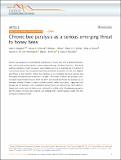Chronic bee paralysis as a serious emerging threat to honey bees
Abstract
Chronic bee paralysis is a well-defined viral disease of honey bees with a global distribution that until recently caused rare but severe symptomatology including colony loss. Anecdotal evidence indicates a recent increase in virus incidence in several countries, but no mention of concomitant disease. We use government honey bee health inspection records from England and Wales to test whether chronic bee paralysis is an emerging infectious disease and investigate the spatiotemporal patterns of disease. The number of chronic bee paralysis cases increased exponentially between 2007 and 2017, demonstrating chronic bee paralysis as an emergent disease. Disease is highly clustered spatially within most years, suggesting local spread, but not between years, suggesting disease burnt out with periodic reintroduction. Apiary and county level risk factors are confirmed to include scale of beekeeping operation and the history of honey bee imports. Our findings offer epidemiological insight into this damaging emerging disease.
Citation
Budge , G E , Simcock , N K , Holder , P J , Shirley , M D F , Brown , M A , Van Weymers , P S M , Evans , D J & Rushton , S P 2020 , ' Chronic bee paralysis as a serious emerging threat to honey bees ' , Nature Communications , vol. 11 , 2164 . https://doi.org/10.1038/s41467-020-15919-0
Publication
Nature Communications
Status
Peer reviewed
ISSN
2041-1723Type
Journal article
Description
This work was funded jointly by BBSRC grants BB/R00482X/1 (Newcastle University) and BB/R00305X/1 (University of St Andrews) in partnership with The Bee Farmers’ Association and the National Bee Unit of the Animal and Plant Health Agency.Collections
Items in the St Andrews Research Repository are protected by copyright, with all rights reserved, unless otherwise indicated.

